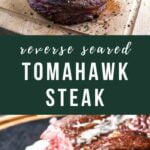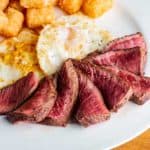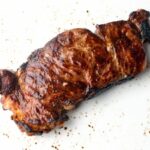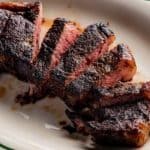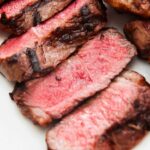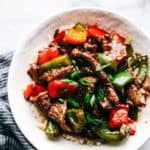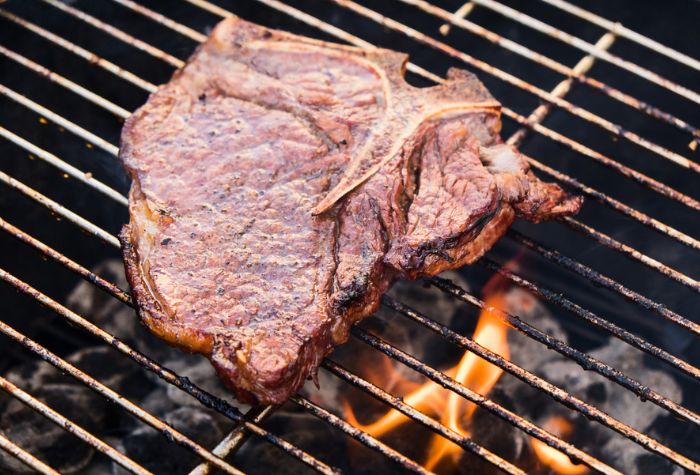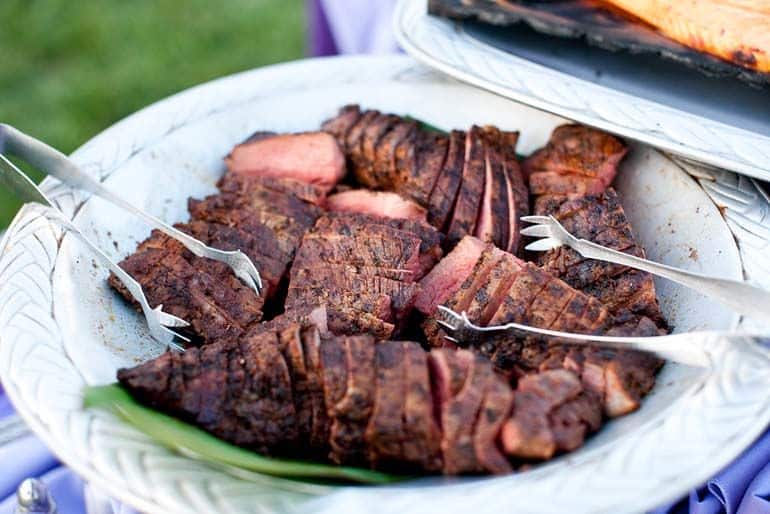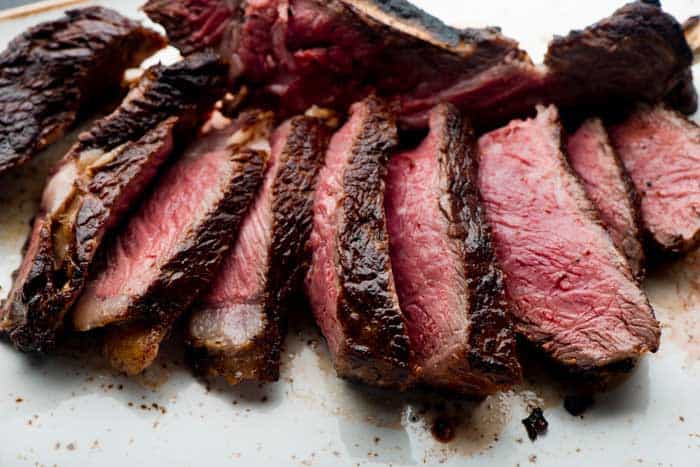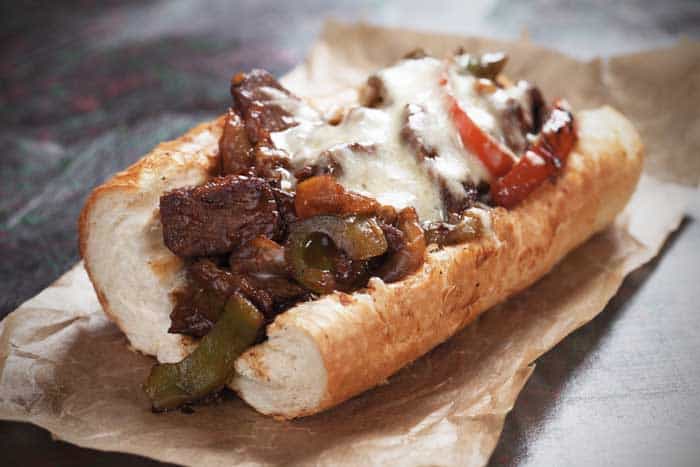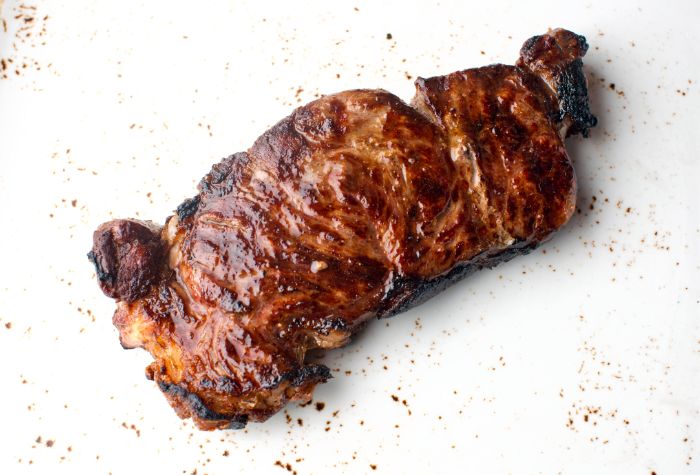Reverse searing is the best way to cook your tomahawk steak to perfection. With a touch of butter and BBQ rub before smoked over charcoal, there’s nothing quite like this cut of barbecue beef.
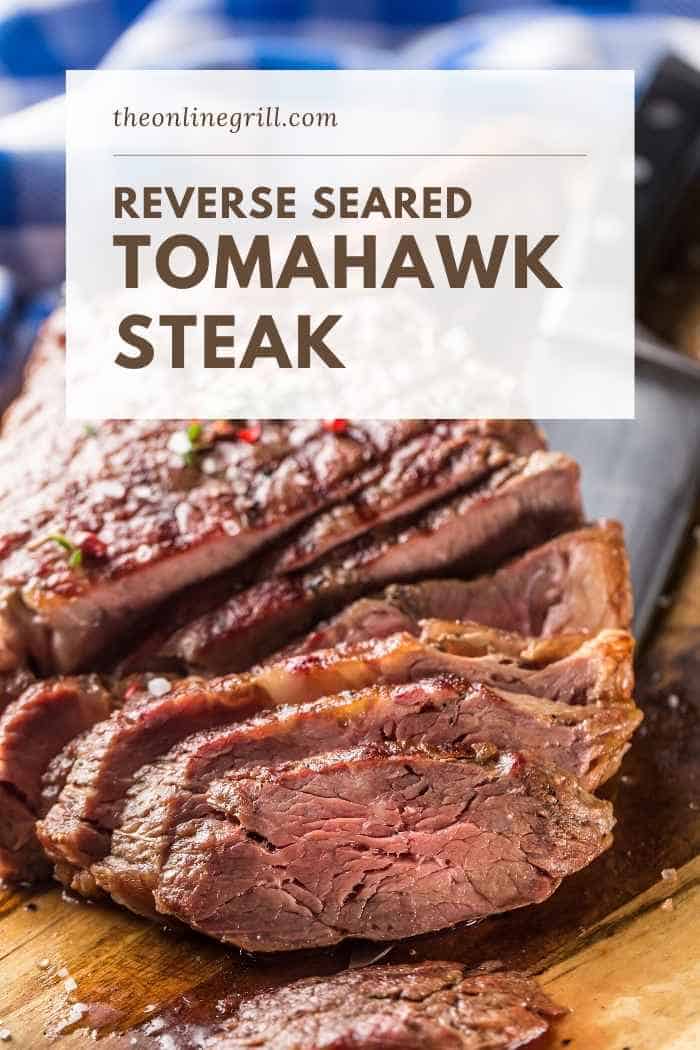
What is a tomahawk steak?
Supposedly named because of its resemblance to a tomahawk axe, its name might throw a lot of people, but you’re probably more familiar with it than you might think.
Few people have actually had it due to its high price point, but if you’ve had rib eye then you’ve essentially had tomahawk.
Tomahawk steak is a show stopping cut of meat that’s essentially a rib eye, but with the large bone left in. It’s cut from the fore ribs, with the entire rib bone left in. It’s then French trimmed, where part of the fat and meat is is cut away to expose the bone (source). It’s usually about 1kg in weight, and a couple of inches thick, making it more than large enough to feed a couple of people.
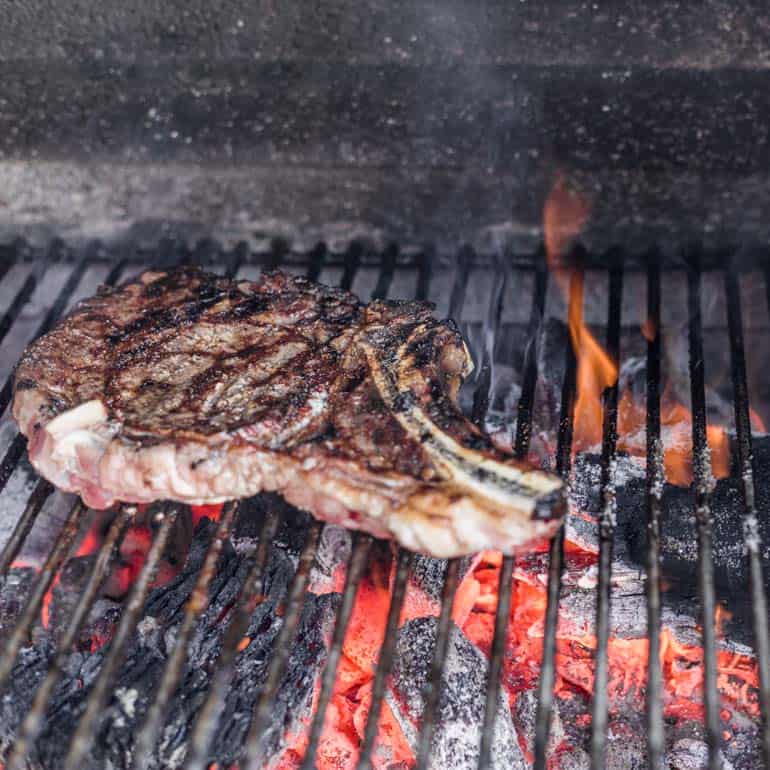
If you’re a fan of T-bone or Porterhouse steaks, then the Tomahawk should be next on your list of meats to try. It uses the same main muscle, so carries a lot of the same texture and flavors.
Some say it’s just a stunt to add a bit of wow factor for extortionate cost. But who am I to judge?
You’ll probably only see it at high-end restaurants, but it is slowly becoming more and more common as its popularity grows. It’s showing up at more upmarket places and butchers, so don’t be surprised if it’s widely available within a couple of years.
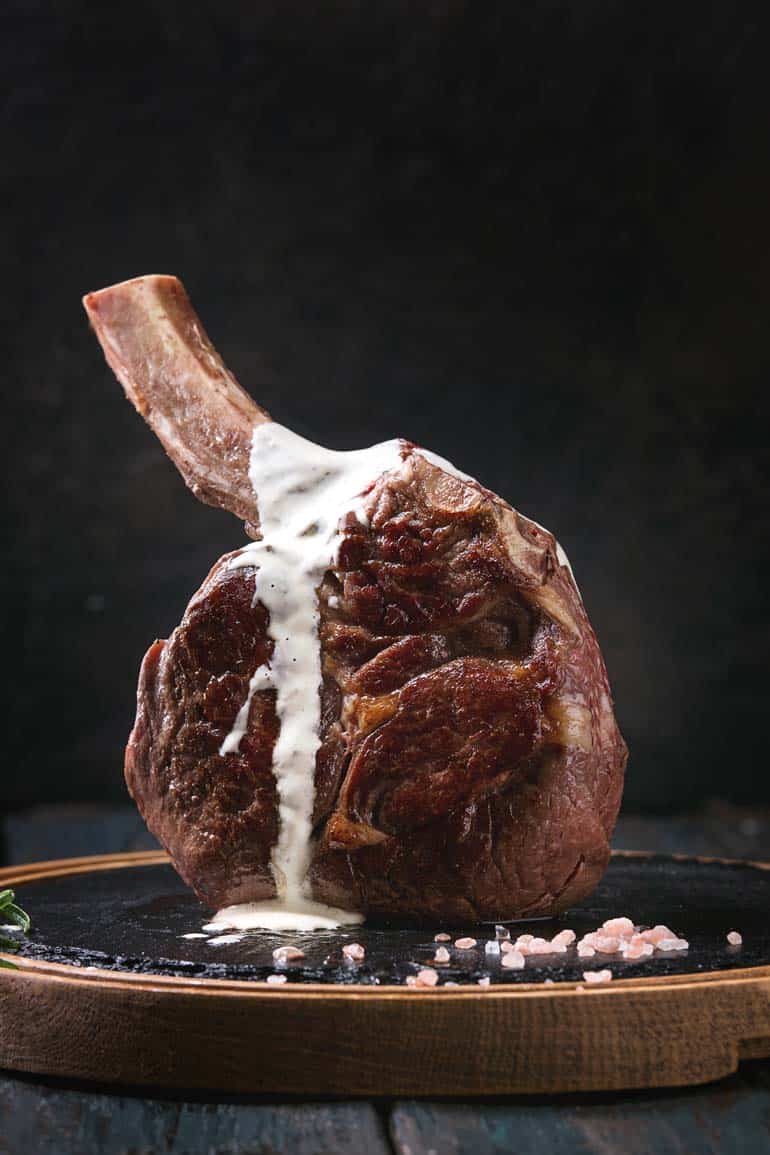
While its detractors say it’s just an excuse to sell an average bit of rib eye with a bone in it, it does have its fans.
Besides being a table centrepiece, it does have the added benefit of being slightly more succulent than regular rib eye. With the bone left in, it contains more Intramuscular fat (or marbling). This gives it more moisture and flavor, as the fat will render and start to melt through the meat as it cooks. It also tends to be much thicker than rib eye, but that’s more a case of the way it is typically cut rather than the meat being inherently thicker.
What is reverse searing?
Reverse searing involves cooking meat slowly, gradually bringing the temperature up, before then searing it over extremely high heat.
It’s a great method of cooking as it gives you greater control of the internal temperature of your meat. The importance of this can’t be overstated, and I’ve written about it in great detail when talking about smoking meat.
Not only does it give you control, but it helps produce a tender portion of steak with a beautiful brown crust.
The method ensures accuracy in comparison to conventional methods of simply searing steak, which usually results in a pink center and brown crust. The problem with this is while it can produce beautiful results sometimes, other times you can be left with something either too rare or too tough.
And when cooking something expensive like tomahawk we want to be confident that the results will be flawless.
The good news is that reverse searing can be done either in the oven or in the grill. Cooking it at a slow heat also helps to dry out the surface of the meat, which creates perfect conditions for searing it.
And when you do sear it, the crust it produces is part of the Maillard Reaction, which is a process that helps elevate the flavor of food, particularly when food is ‘browned’ on its surface.
How to reverse sear tomahawk steak
Because it’s a large cut of meat, a lot of people prefer to oven roast Tomahawks. I prefer to grill it however, so today I’m going to show you how to cook it over a charcoal grill.
Like with any meat, internal temperature is key so you’ll need a good meat thermometer. You’ll be aiming for an internal temperature of 140°F (60°C) to achieve a medium-rare level of doneness.
Reverse searing is a bit easier to do in an oven or gas grill because of the easier use of temperature control you get. Charcoal grills are more of a challenge, but if you know how to regulate temperature with your grill’s vents and you know how to use indirect grilling then you should get the hang of it pretty quickly.
If you’re using a gas grill then you might find that your grill is limited in terms of its maximum temperatures. However if your grill has at least two burners (preferably three) then you should be fine.
Pro Tip: If your gas grill is limited with its maximum temperatures then I recommend transferring your steak to a griddle pan for the searing part of the cooking. Place steak directly onto the scorching hot cast iron, flipping every 45 seconds. Do this for about 5 minutes or until desired level of dark crust develops.
How to cut tomahawk steak
After you cook it, you’ll need to allow it to rest for about 10 minutes. This is to allow the heat from the bone to set into the meat, which will help the fat render even more and give you an even more delicious cut of meat.
After you’ve allowed it to rest, you can start to slice it. Cut the meat by holding the bone with one hand, and using your other hand to cut lengthways along the edges of the bone. This will help you remove the bone from the meat cleanly.
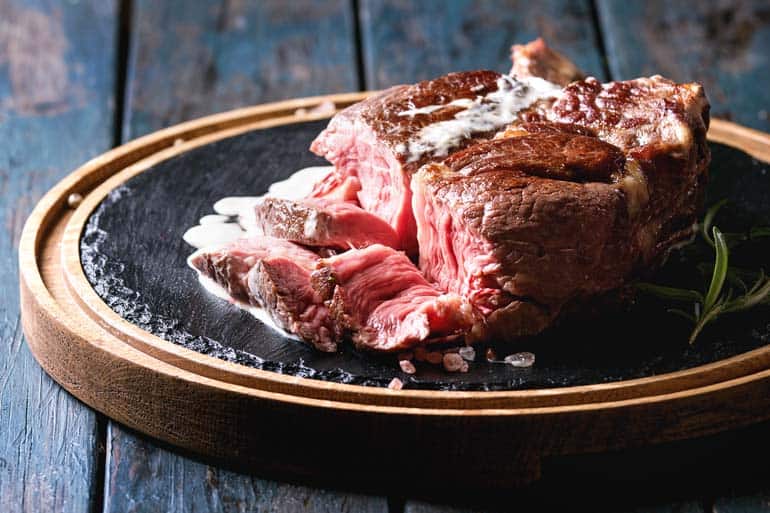
Use the marbling of the meat as a guide and aim to cut against the grain into slices. Make these slices as thick as you prefer (personally, I like it thick). It’s a special cut of meat, so why not cut decadent slices off it?
Steak prep tips
Get a good steak rub
It’s worth treating the steak well, so try not to use a ready made store bough version, but rather try to make something homemade. I recommend this herb and spice rub.
Use butter
This might come down to your personal preference, but adding butter is a great way to add even more flavor to your steak. It can mix well with the fats in the meat, and make it even more juicy. Add a little bit of butter on top after searing it. As the steak rests it will melt and then absorb the butter.
Invest in a good grill thermometer
I can’t stress the importance of this enough. Getting the internal temperature of your meat right isn’t just important for the sake of ensuring good flavor, but also food safety. In-built thermometers in grills tend to be cheap and unreliable, so I suggest buying your own.
If you’re not sure where to start then check out grill thermometer reviews guide for some affordable and solid options. Now on with the recipe!
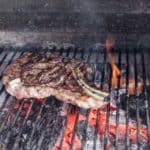
Reversed Seared Tomahawk Steak
Equipment
Ingredients
- 1 Tomawhawk Steak
- 2 oz butter
- BBQ rub to taste
- ground black pepper to taste
Instructions
- Place the steak on a large cutting board and allow to come to room temperature. I recommend leaving for about an hour.
- While it rests, rub with a liberal amount of salt and your chosen BBQ rub.
- Start your grill. If you have charcoal grill then you might need a little bit of time to allow the temperature to reach 225°F.
- Set up your charcoal grill for indirect grilling, or your gas grill with just one burner on at one end of the grill.
- Place your steak on the grill, in the indirect zone of your grill. Insert digital probe meat thermometer into steak, close lid of grill, and allow to cook.
- Leave steak until it reaches internal temperature of 125°F (50°C) for a medium-rare finish, or 130°F (55°C) for medium. The time this takes will depend on the size of your steak, but is often 30-40 minutes.
- On a charcoal grill, open up the vents on your grill to allow greater airflow through the grill chamber, or add more coals and.or wood chips to ramp up the temperature. If you’re using a gas grill, simply turn the heat up to a sear.
- Once ready, transfer the steak to be directly over the heat. Flip every 20 seconds for 3-4 minutes, or until the outer layer develops your desired amount of crust on the outside.
- Remove from heat and leave to rest for 10 minutes before slicing.
- Serve with your choice of topping, such as butter, black pepper, and garlic.
